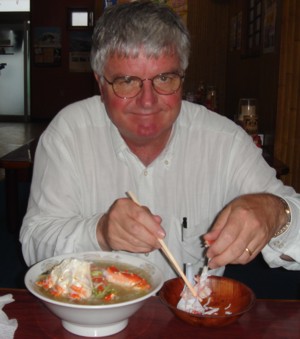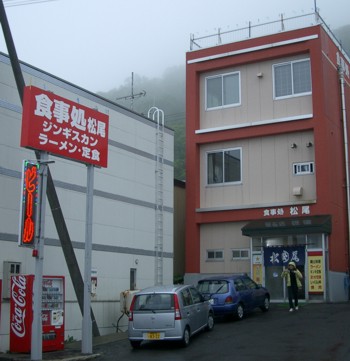Hokkaido - A Trip to the Sodden North
Of course we usually talk about the frozen North, and indeed for Hokkaido this is true for eight months of the year. But our visit was in June, and it almost never stopped raining. Sometimes it was just fine drizzle, and sometimes it was a real downpour. Even when it wasn't raining it was misty with very low cloud. But despite all that, we had a wonderful time.
You can see any picture full size by clicking on it. If you see some strange-looking text, it's because you don't have Japanese characters installed... don't worry about it, just ignore them.
Travel
Watch your step. The road is slippery.
This enigmatic advice appears in the jetways at New Chitose Airport, Sapporo.
International air travel to and from Japan is painful. The flights are invariably long, the immigration queues often horrific, and of course Narita is hours by bus or infrequent train from anywhere you actually wanted to go. Internal air travel on the other hand is a pleasure. For a start, internal flights use Haneda airport, 30 minutes from central Tokyo by a regular monorail service. Once you get there, the experience is like internal flights in the US 15 or 20 years ago. There is security, but it is very low key. Nobody even shows up at the gate until 20 minutes before the flight, and boarding starts 10 minutes before departure time. Anywhere else this would be a recipe for a late departure, but in Japan everyone is very orderly and the doors close on time.
Japan is not a country that attracts foreign tourists. There are plenty in Kyoto and some in Tokyo. But on my flight from Sapporo back to Tokyo - a completely full 767 - I was the only foreigner. I know because the stewardess came and asked me if I wanted announcements in English. That would be unthinkable on a comparable flight from say Nice to Paris.
Trains are wonderful in Japan. Everyone knows about the Shinkansen or "bullet train", but the regular trains are a real treat too. We took the limited express train which goes across Hokkaido from Sapporo to Abashiri on the east coast. It isn't particularly quick, but it runs on schedule to within better than a minute, making about a dozen stops. Every half hour or so a girl comes through the train with a trolley selling drinks, snacks and o-bento lunch boxes. The monthly timetable published by the Japanese Railways lists not only every single train in the country, private lines as well as JR ones, but also all the rural bus services, long distance express buses, ferries, and all flights both national and international. You can go anywhere with the JR timetable.
I hoped to see sheep as we crossed Hokkaido. We saw cows but no sheep. In fact we didn't see any sheep at all in Hokkaido, the whole time we were there. It was disappointing. Part of the original inspiration for our trip there was Murakami's book A Wild Sheep Chase, which is mostly set in Hokkaido. Maybe we were in the wrong part, or maybe they were all hiding. The fascinating thing about Hokkaido is how empty it is. I love Tokyo, but it is unbelievably crowded. Even small Japanese towns manage to feel busy and crowded. Apart from Sapporo and a few other towns, Hokkaido is a rural wilderness, with a lot of agriculture and lumber yards. It reminded me of Wales or Scotland.
Shiretoko (知床)
 We didn't stop in Abashiri, which
according to the guide book is the best thing to do. We picked up a
rental car from Mazda, just in front of the station. Because
long-distance driving is really not a good idea in Japan - and many
people don't own cars - every town has rental cars available at the
main railway station. (The maps in the JR timetable even have a symbol
for stations where you can rent cars). Our first stop was at Utoro
which is a fishing port and tourist town on the Shiretoko peninsula,
the long, thin finger that sticks out on the eastern side of Hokkaido
towards Sakhalin in Russia. On the way we stopped at one of the most
famous waterfalls in Japan, which is conveniently beside the main road
with its own car park. Most waterfalls, understandably enough, are in
inaccessible places high in the mountains and you have to clamber up to
them, but this one falls almost directly into the sea.
We didn't stop in Abashiri, which
according to the guide book is the best thing to do. We picked up a
rental car from Mazda, just in front of the station. Because
long-distance driving is really not a good idea in Japan - and many
people don't own cars - every town has rental cars available at the
main railway station. (The maps in the JR timetable even have a symbol
for stations where you can rent cars). Our first stop was at Utoro
which is a fishing port and tourist town on the Shiretoko peninsula,
the long, thin finger that sticks out on the eastern side of Hokkaido
towards Sakhalin in Russia. On the way we stopped at one of the most
famous waterfalls in Japan, which is conveniently beside the main road
with its own car park. Most waterfalls, understandably enough, are in
inaccessible places high in the mountains and you have to clamber up to
them, but this one falls almost directly into the sea.
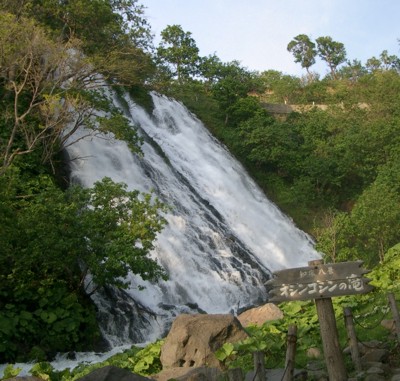 Shiretoko is an Ainu word, like many
of the placenames in Hokkaido, but it is written using Kanji as if it
was a Japanese place name. Mainland placenames have boringly
straightforward meanings - Eastern Capital (Tokyo), Green Forest
(Aomori),
Big Slope (Osaka) and
so on. Hokkaido placenames seem very enigmatic until you realise that
they are just using the Kanji phonetically. Shiretoko means "known
floor". Utoro however seems to have been too much, and is spelled in
Katakana (ウトロ). It's a shame, because it could have been written
鵜瀞, with an apt meaning of "cormorant pool".
Shiretoko is an Ainu word, like many
of the placenames in Hokkaido, but it is written using Kanji as if it
was a Japanese place name. Mainland placenames have boringly
straightforward meanings - Eastern Capital (Tokyo), Green Forest
(Aomori),
Big Slope (Osaka) and
so on. Hokkaido placenames seem very enigmatic until you realise that
they are just using the Kanji phonetically. Shiretoko means "known
floor". Utoro however seems to have been too much, and is spelled in
Katakana (ウトロ). It's a shame, because it could have been written
鵜瀞, with an apt meaning of "cormorant pool".
When we arrived in Utoro, all of the fishing boats in the port were decorated with brightly coloured banners. They looked wonderful. We managed to get some pictures before they were all removed, but we didn't find out what they were celebrating.
Our hotel was a typical Japanese luxury tourist hotel.
The rooms were Japanese style, tatami on the floor and sleeping on
futons which are laid out by the staff during dinner. The first thing
to do after arriving was take a bath in the magnificent public bath at
the top of the hotel. From the hot water (a just-bearable 42° or so) you look out through
huge panoramic windows over the harbour and the Sea of Okhotsk. For the
hardy there was also a rotemburo, an open-air bath on the roof. I went
up there and thoroughly enjoyed it. It is of course pretty cold when
you first step outside with no clothes on, but the hot bath is
wonderful to step into. And there's something very pleasant about being
in hot water up to the neck and feeling the cold night air on your
face. The next
 night, at Akan, I went in the
rotemburo in very light rain, which was actually very pleasant.
night, at Akan, I went in the
rotemburo in very light rain, which was actually very pleasant.
Dinner came next. I was a bit apprehensive because the hotel confirmation said it was a buffet - and we've all experienced hotel buffet meals. In Japan this is actually called a "Viking". In England we associate the Vikings with raping and pillaging but the Japanese obviously have a different historical relationship with Scandinavia. In any case my worries were completely unfounded. The food was extraordinarily good, delicious sashimi of a freshness which even in Tokyo you don't experience. This was also our first taste of Hokkaido crab, giant legs filled with tender meat with only the most subtle flavour.
Although we finished dinner quite early, we were dead tired and went straight to bed afterwards - well, to sleep anyway, on our futons. Breakfast the next morning was just as exceptionally good as dinner. I'm normally a bit too fragile in the morning to take a Japanese breakfast, but this one was really good. Western style breakfast was also available, and most of the Japanese people - which is to say everyone except us - seem to take a mixture of the two.
We had a brief moment of worry when I lost the ticket for the valet parking. I practised the Japanese I would need to explain this, but there was no need - it only took a gesture for them to understand and fetch the car. Even in an out-of-the-way place like Utoro, nearly everyone arrives in tourist buses. Individual visitors who show up in their cars are very rare. The hotel had about 400 rooms and there were maybe a dozen cars parked overnight. And gaijin (foreigners) in cars are so unusual that the staff remembered us and our car without prompting.
Our first stop that morning was at the Shiretoko Five Lakes, a group of lakes (you can guess how many) connected by marshes. They were pretty, but honestly not all that special. We'd rejected the idea of taking a boat trip, even though this is the only way to see the tip of the Shiretoko peninsula - there are no roads. The trip lasts nearly four hours and the weather was turning nasty, although the rain had not yet started. (The boat times are, of course, in the JR timetable, page 799 section 2 of the June 2006 edition).
We could only visit three of the lakes, the other two were closed. Well, the path was. Although it was mid-June the snow had only cleared in the previous few weeks, and I think they were still repairing snow damage in many places. There was still snow on the mountain tops that we'd seen from the train. (Maybe others too, but we never saw any mountain tops after that). There is a very famous waterfall further out on the peninsula. The water comes from hot springs and there are pools where the hardy can bathe. But the road was closed, so we didn't get to try it. By then it had started to pour with rain anyway. Our journey took us over the Shiretoko Pass, a road which crosses the spine of the peninsula with magnificent views of both coasts and in all directions. Or so they say. We could barely see the road ahead of us, driving in the cloud and with torrential falling rain. We came down the other side wondering when we would get out of the cloud. The answer turned out to be at about a hundred feet above sea level, as we arrived in the larger fishing port of Rausu.
This was a fairly unlovely place, in the heavy rain, but we wanted to find somewhere for lunch so we drove round it, ending up by the dockside. Then I saw a sign for "Kani Ramen", noodles with crab (kani). We turned down a side street that led us in amongst the warehouses and trucks. Tucked in among the big trucks was a small restaurant. The inside was rather shabby but we were hungry, so we took our shoes off, sat on the tatami and ordered two kani ramen lunches. When they came they were huge, with what seemed like dozens of giant crab legs, each packed with finest, freshest meat. It took us ages to pick it all out and eat out. The other customers were truck drivers and dock workers, but the food was delicious, as good as anything you would eat in the finest restaurant in Tokyo.
Our drive along the rain-drenched coast was interesting but there wasn't much to see. The cloud hugged the hillside a hundred feet above the ground. Every few kilometres there was another fishing port, with a dozen or so identical boats. Somewhere along the way we stopped at a visitor centre which turned out to be a big fish market. Sadly there was no point in us buying any of the delicious-looking fresh fish, but Isabelle did buy some chocolate kombu. This has to be one of the most improbable foods known to man. Kombu is dried seaweed, about which more later. It is chewy, almost like chewing gum, though harder, and tastes of... seaweed. Covering it in chocolate seems like a very odd choice. We didn't pluck up the courage to try it before I left Japan, so I can't comment on the gustatory experience. While I was in the bathroom Isabelle came very close to being herded into a tourist bus by a panicked guide who couldn't believe that anyone could get there any other way.
Probably the main reason the centre is there is that it is the closest point in Japan to the Kuril Islands, just 20km away in the Sea of Okhotsk. These were in Japanese hands for a long time, but during World War II the Russians claimed them, and have been claiming them ever since. There are seven islands, but in Japanese they are called Chishima which means "thousand islands". In any case they are still an unresolved problem between Japan and Russia, and the reason why the two countries have never officially ended WWII. Needless to say, we didn't see them.
Eventually we left the coast and drove inland towards our next overnight stop, at Akan. On the way we passed a private airfield, which was a big surprise. Hokkaido has quite a few commercial airports, all with several daily flights to both Sapporo and Tokyo (full details of course in the JR timetable), but small airfields are very rare in Japan, where private flying is practically unknown. There was absolutely no sign of life there, just one locked hangar marked "Hokkaido Air" and a little closed office. No aircraft were visible.
Akan (阿寒)
Akan is a region famous for its three volcanic caldera. We planned our route with a detour that would take us past two of them, spending the night at the third. The first is Mashu-ko, famed as the clearest and deepest lake in Japan. We paid our ¥410 to park at the visitor centre and went in. Outside on the viewing terrace it was pouring with rain, but it didn't matter because there was absolutely nothing to see. The rim of the caldera is quite high above the lake, and the only thing visible was mist. So we contented ourselves with cups of green tea as we strolled around the tourist junk on sale. Japan is rightly admired for the beauty of its traditional culture and art, but it is also the world capital of tourist junk. Every tourist town, every remote tourist bus stop like this one, is packed with the stuff. Hokkaido is famous for its bears, so everywhere you go there are bear sweatshirts, bear baseball caps, bear tea-towels, bear bumper-stickers... all carrying enigmatic messages like "A big hardwood straighten its head on the ground". Japan and its culture are of course famously deep and enigmatic, but actually I think most of it is due to dubious translation.
We abandoned our plan to
visit the second invisible lake, and took the mountain road across to
Akan-ko. Our hotel there was another palace, with a huge atrium and
magnificent views of the lake. Right under our room was a small dock
lined with pedal boats, some made to look like swans and others - and
I'm not making this up™ - like helicopters, complete with
rotor blades and tail rotors. Sadly nobody rented one while we were
there, so I didn't get to see whether the rotors turned with the
pedals. I can't help wondering who decided that helicopter-pedalos were
just the thing for this remote and beautiful lake in the depth of the
Hokkaido mountains. But it gets better. A few yards away was another
dock with family-size motor boats for rent. These were made to look
like 727s, with three pretend jet engines and a tailplane. Honest.
 And if you look carefully you can see that the boats are equipped with
radar. Considering that the furthest they can go is two kilometres away
at the other end of the lake, this tells you quite a lot about the
local climate.
And if you look carefully you can see that the boats are equipped with
radar. Considering that the furthest they can go is two kilometres away
at the other end of the lake, this tells you quite a lot about the
local climate.
The bath and the rotemburo at this hotel were even better than the previous one. I sat in the hot water of the rotemburo with fine drizzle falling on my head, looking out over the darkness of the lake and the mist-shrouded mountains. It was magic. This hotel's Viking was a disappointment compared to the previous one - the food was OK but not exceptional. And I encountered a couple of gai-pani moments. Gai-pani (外パニ): from gaijin-paniku, terror induced by the idea of having to communicate with a non-Japanese - thanks to my friend Kumiko-san for coming up with the word. Some Japanese are convinced that communicating with foreigners is impossible. Embarrassed by their own understandably limited English and convinced that no foreigner could possibly speak any Japanese, they cringe in terror as you try to talk to them. Speaking Japanese just makes it worse - since gaijin could only be speaking English, they try to parse your Japanese as English and of course fail completely, leading to complete panic. In a Starbucks in Sapporo, the teenage server and I were reduced to sign language even though her English and my Japanese were both perfectly adequate for what we needed to communicate.
 The next morning we went for a walk
around the town. Luckily it was too early for most of the gift shops.
However the Ainu village was already open, so we did get to see some
typical tourist junk this time with an Ainu theme. There were plenty of
bears too. The Ainu are the native race of Hokkaido, with a lot in
common with the American Indians racially and from several other
points of view as well.
Isabelle noticed that their traditional art (at least as represented in
the tourist stuff) has a lot in common with what we have seen in
Arizona. And, like the American Indians, there aren't many of them left.
The next morning we went for a walk
around the town. Luckily it was too early for most of the gift shops.
However the Ainu village was already open, so we did get to see some
typical tourist junk this time with an Ainu theme. There were plenty of
bears too. The Ainu are the native race of Hokkaido, with a lot in
common with the American Indians racially and from several other
points of view as well.
Isabelle noticed that their traditional art (at least as represented in
the tourist stuff) has a lot in common with what we have seen in
Arizona. And, like the American Indians, there aren't many of them left.
Our route the next day included a minor road in the mountains. It was numbered, and marked on our map but I wouldn't have found it without the GPS moving map. The turnoff was completely unmarked and even when we saw it, it just looked like a forest track. I wasn't even sure it had a hard surface. But a sign said it was open for its whole length, so we tried it. I don't know why they were so coy about it. The surface was old and in poor shape, but no worse than a lot of minor roads in the US. In any case it made a very pleasant route. Near the beginning was a very pretty lake, one which we could actually see - we made that our own personal Mashu-ko. We only saw one other car on the road, despite stopping several times.
Our first stop was at Tsurui, home to the famous red-headed cranes or "tancho" which are an emblem of Japan - as used, in a very symbolised form, on the tail of JAL's aircraft until recently. We stopped for coffee at a little cafe which was completely dedicated to them, with a viewing gallery and lots of pictures, and a few serious books, but no junk at all which was a pleasant change. Then we went to the visitor centre which was also pleasantly junk-free. There they showed wonderful videos of the birds, including their amazing courtship dances in February which have become a pilgrimage for some people. They are huge birds, standing about four feet tall and as heavy as a turkey, but they fly beautifully. There was a trail around the visitor centre, but it was raining so hard that we didn't bother. I doubt that we would have seen any cranes anyway.
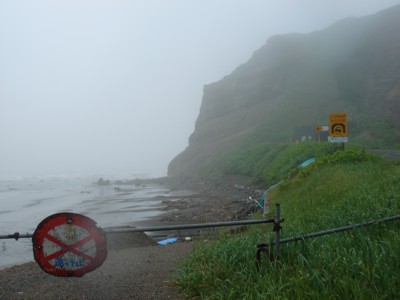 We met the coast again at Kushiro, the
local big town. The exit from Kushiro took us through a depressing
alley of strip malls and car dealerships - the approaches to Japanese
towns aren't very different from the US. By then we were hungry, and we
found another cafe offering a Kani Lunch Special. Then the main road
left the coast for a while, but our map showed a minor road that stuck
to it, although it wasn't certain we could follow it all the way. But
we tried anyway, and were rewarded with an absolutely spectacular
drive. It was still pouring with rain, but on the deserted coast road
this just added to the atmosphere as we twisted alongside the empty
beaches. The final stretch twisted up a hillside, a single-lane track, before suddenly turning into a major highway
in the middle of nowhere. This was very strange.
We met the coast again at Kushiro, the
local big town. The exit from Kushiro took us through a depressing
alley of strip malls and car dealerships - the approaches to Japanese
towns aren't very different from the US. By then we were hungry, and we
found another cafe offering a Kani Lunch Special. Then the main road
left the coast for a while, but our map showed a minor road that stuck
to it, although it wasn't certain we could follow it all the way. But
we tried anyway, and were rewarded with an absolutely spectacular
drive. It was still pouring with rain, but on the deserted coast road
this just added to the atmosphere as we twisted alongside the empty
beaches. The final stretch twisted up a hillside, a single-lane track, before suddenly turning into a major highway
in the middle of nowhere. This was very strange.
Our journey that day was a long one, and by mid-afternoon we were ready for a break and a cup of tea. We began to realise something very strange about Japan. The cities are absolutely full of cafes. There's a Starbucks on every corner (Sapporo's main railway station has two of them), and many Japanese chains and independent places. Yet when you go into the countryside there is nothing. We looked in the town of Hiroo for a coffee shop. It was a dismal place in the rain, completely deserted on a Saturday afternoon. We drove up and down the main street and several side streets before finally coming to a hotel with a cafe, but when we went in it was closed. From the hotel receptionist we managed to get directions to another place, which we even managed to find. It was tiny, and we were the only customers for the whole time we were there. The service was of course impeccable, if expensive, and they even had an English-language menu though goodness knows how often they get to bring it out. On our way out of town we stopped for gas, and were surprised to be given not just one but five large boxes of tissues. We had no idea what to do with them and left them in the car when we dropped it off.
Erimo Misaki (襟裳岬 or えりも岬)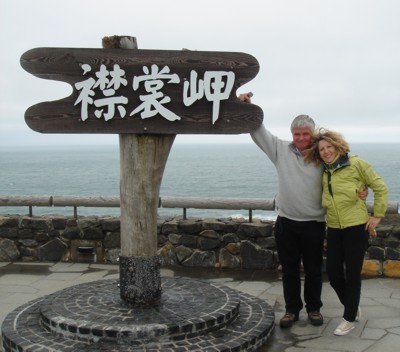
After Hiroo we started down the peninsula at whose tip lies Erimo Misaki ("misaki" means "cape"). This is the pointy bit on the south side of Hokkaido. There are only two roads down the cape, hugging the coast on either side. The eastern road is the more spectacular, clinging to a narrow ledge between the mountains and the sea, and often resorting to tunnels. There are a few small fishing villages, and between them the occasional cluster of damp, sorry-looking houses and huts. The sea gets rougher and rougher as you get closer to the cape itself. Finally, after turning off the main road and driving a few more kilometres, we reached Erimo Misaki. There was one puzzle on the road: there's a sign every kilometre, and each sign has a symbol of some animal associated with the area: a bear, a seal and so on. The signs weren't all different, but changed from time to time. We never did figure out what their significance was.
The village of Erimo Misaki nestles in a hollow a few hundred metres from the cape itself. It has a large artificial harbour with a couple of dozen fishing boats, and a small supermarket where we were able to top up our supplies of excellent Japanese chocolate.
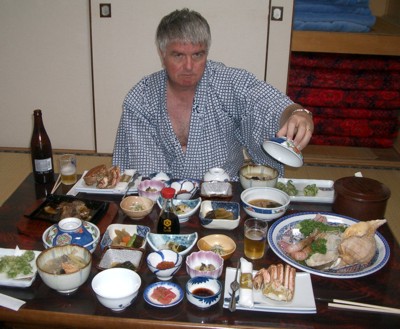 Our
ryokan was on the cape itself. It was unbelievably windy when we
arrived, and as the evening wore on the wind became stronger and
stronger. By the time we went to bed it was truly howling, the building
shaking with each gust. The windows rattled terribly until Isabelle did
some bricolage with pieces of paper and wedged them
tight. This ryokan was much more traditional - the other two were giant
luxury hotels whose only concession to Japanese style was the
tatami-style rooms. This one had just ten rooms
and a shared toilet and bath, and was run by a live-in
family. Dinner was served in our room and was an absolutely splendid
assortment of sashimi, among the best we've ever had. Everything was
incredibly fresh, not surprising since we were told that every single
item had been fished locally, in the village. But just for variety, we
were also served with some delicious, tender braised venison. A special
bonus was a plate of
four whole sea urchin
("uni"). Normally there is only a scraping of roe (the edible part)
inside, but these were stuffed full. It was a great treat to be given
it, but neither of us is a huge fan of uni. It would have been rude to
leave it, so we packed up what we didn't eat in a bag and dealt with it
the next day.
Our
ryokan was on the cape itself. It was unbelievably windy when we
arrived, and as the evening wore on the wind became stronger and
stronger. By the time we went to bed it was truly howling, the building
shaking with each gust. The windows rattled terribly until Isabelle did
some bricolage with pieces of paper and wedged them
tight. This ryokan was much more traditional - the other two were giant
luxury hotels whose only concession to Japanese style was the
tatami-style rooms. This one had just ten rooms
and a shared toilet and bath, and was run by a live-in
family. Dinner was served in our room and was an absolutely splendid
assortment of sashimi, among the best we've ever had. Everything was
incredibly fresh, not surprising since we were told that every single
item had been fished locally, in the village. But just for variety, we
were also served with some delicious, tender braised venison. A special
bonus was a plate of
four whole sea urchin
("uni"). Normally there is only a scraping of roe (the edible part)
inside, but these were stuffed full. It was a great treat to be given
it, but neither of us is a huge fan of uni. It would have been rude to
leave it, so we packed up what we didn't eat in a bag and dealt with it
the next day.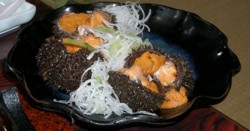
First stop the next day had to be the Wind Museum (風の官). At Erimo Misaki the wind is stronger than 20 knots (10m/sec) on 290 days per year. We could certainly believe it. The previous night's gale had subsided to just an ordinary strong wind, but it was still impressive. Entry to the museum is through a long curving underground corridor, with strange eerie lighting which turns out to be controlled according to the strength and direction of the wind above. Once inside, a lot of the displays are actually about the harbour seals which live out in the rocks. There is a big viewing gallery with powerful telescopes. We couldn't see anything at first, but then a helpful guy outside came by and cleaned all the salt spray off the windows, and then we could clearly see the groups of seals. (I don't know what Mazda Rent-a-Car made of our car when we returned it, covered in a thick layer of salt spray, in Sapporo). We'd wondered what could possibly be in a Wind Museum, but in the end we spent a couple of hours there.
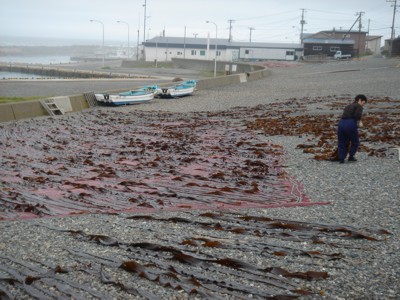 In
addition to fish, Erimo is also a big producer of kombu, the dried
seaweed mentioned earlier. All around the town are large gravel areas,
carefully raked and set at a slight slope, where bent-backed old women
carefully spread out the long, thick strands of seaweed to dry.
In
addition to fish, Erimo is also a big producer of kombu, the dried
seaweed mentioned earlier. All around the town are large gravel areas,
carefully raked and set at a slight slope, where bent-backed old women
carefully spread out the long, thick strands of seaweed to dry.
Return to Sapporo
After Erimo Misaki, the only thing left to do was to return to Sapporo, 200 km away, We drove up the west side of the cape, a lot less wild than the east side with good sized towns every few kilometres. Each town had its kombu-drying area. We bought a picnic lunch in one town, and ate it sitting beside the sea. The Japanese don't seem to have much notion of "seaside" - you never see anyone on the beach, despite - or maybe because of - their very close historical relationship to the sea. So we had the beach and the ocean to ourselves, apart from a huge crow which waited patiently for us to finish, then flew off triumphantly with a whole sandwich in its beak, fending off the other crows which came as soon as they saw what they were missing.
It was a long drive and with less interest than the previous day, so we were very glad when we could join a new highway about half way back. This was obviously a very expensive piece of engineering, with huge cuttings, long embankments and big bridges. Yet it was built in a uniquely Japanese style, the two-lane divided highway. That's right, in each direction there's just one lane, shared by everyone. We came across one of these a few years ago, on the Izu pensinsula, where it had turned into a very long traffic jam. This one was fine though, and ran smoothly. Japanese speed limits are very low - never higher than 100 km/h and often only 80 km/h even on the highway - so everyone drives at much the same speed, which may explain the design. Still, it seems strange to spend that much money to build something so limited.
I was apprehensive about our return into Sapporo. First we had to find the way into the city centre, then we had to find our first hotel, collect the bags we'd left there, find the second hotel, and then return the car - made more complicated because I'd lost all information about where to return it. But in fact it all went very smoothly. Isabelle did a great job of navigating, and the GPS helped a lot too by making sure we always knew exactly where we were. (I never bothered to try and program it. I still remember the GPS in our rental car when we went to Noto Hanto last year, which had been programmed to return to its depot in Kanazawa. It spent the first couple of hours of our journey pleading with me at every exit to leave the highway and turn around, in its very dainty feminine voice, before I finally figured out how to turn it off)
Once we'd dealt with all that, it was time for dinner. Sapporo is famous for its beer, and its two European-style beer-halls are major tourist attractions. We didn't know where else to go anyway, so we went to the Sapporo Beer Hall. What a disappointment. The only thing on offer was an inferior version of "Genghis Khan", lamb grilled on a hot stone at the table, which after all the wonderful food of the previous few days was just about inedible. The beer was good, but you can get it anywhere in Japan, including plenty of restaurants that serve excellent food. Verdict: don't bother,
That was our only letdown though. We thought Hokkaido was a wonderful place - despite the rain - and we're looking forward to returning in winter when everything is covered in snow.
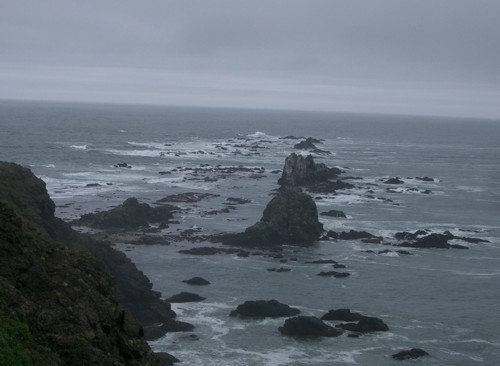
Next stop, California... looking out to sea from Erimo
Misaki
